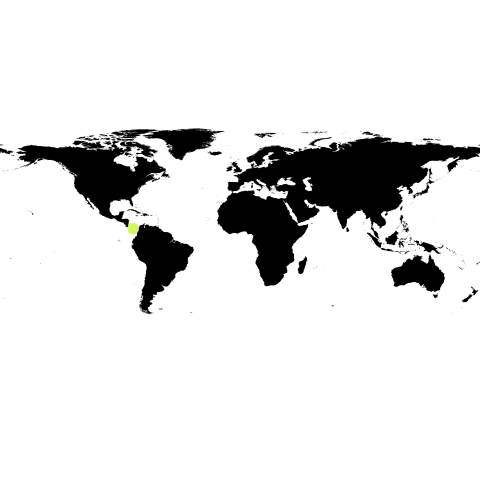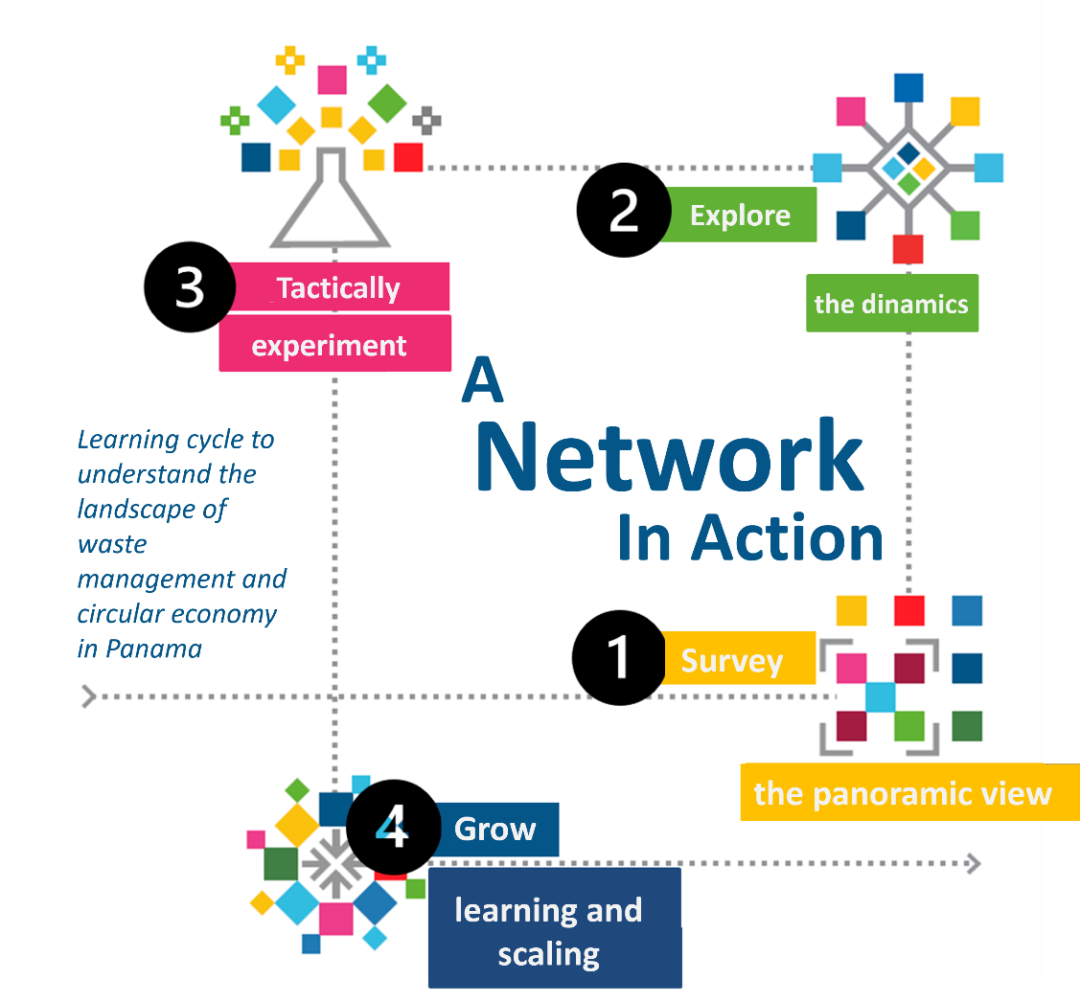Disclaimer:
Please be aware that the content herein has not been peer reviewed. It consists of personal reflections, insights, and learnings of the contributor(s). It may not be exhaustive, nor does it aim to be authoritative knowledge.
Learnings on your challenge
What are the top key insights you generated about your learning challenge during this Action Learning Plan? (Please list a maximum of 5 key insights)
1. Thinking in systems in relation to solid waste management and circular economy is a tough challenge. After the solutions mapping on circular economy and SWM actions, we identified a set of dynamics that were also systems in their own. For example, thinking of organic waste and food systems, where we identified emerging clusters of actors and solutions; as well as plastics, where multiple global, regional and local initiatives are taking place.
2. Our two streams of experiments, (i) circular economy in public markets and (ii) municipal recycling (with a focus on plastics) have positioned our work as a Lab within the circularity domain; as well as the active use of the solutions mapping platform to map and identify actors in relation to these topics as part of current UNDP projects on solid waste management with GEF-Minisitry of Health (Municipal Solid Waste Management in rural municipalities) & WEF-Ministry of Environment (Global Plastics Action Partnership).
3. Generating a circular economy in public markets requires understanding and empathizing with the realities of the people who inhabit it, their hard work in the market and aspirations; putting people at the center is key to the development and continuity of the initiative. Nothing meaningful and lasting (in the personal or digital environment) is built without trusting relationships, especially with the people who work at the San Felipe Neri Market.
4. Outside the capital's bubble there are worlds to know: The solutions mapping process showed how there are a large number of community initiatives that address the challenge of SWM, especially in the peripheries of Panama City. However, even if some of them are known by local governments, those are not recognized or incorporated in the actions/planning of municipalities and institutions on SWM. Their inclusion is key to accelerating circular economy initiatives at the territorial level & beyond.
5. To create changes that are sustained over time, an ecosystem of actors is required, including all sectors (startups, NGOs, institutions and the private sector) and, for the case of markets, extending this vision to the network of peripheral markets. It is important to build a network of complementary actors and alliances that address circularity from a systemic perspective. Integrating actions, avoiding duplication of efforts, enhancing impact and resource efficiency.
Considering the outcomes of this learning challenge, which of the following best describe the handover process? (Please select all that apply)
Our work has been picked up by UNDP or the government and has now expanded geographically in our country, Our private sector partners have expanded our joint work through their own resources in our country or internationally
Can you provide more detail on your handover process?
UNDP/Municipality of Panama: In the case of the Mercado San Felipe Neri as a circular economy lab, we are currently contributing to a new ProDoc with the Municipality of Panama, where we seek to replicate these pilots through the municipal network of markets across the district of Panama; in addition to adopting learnings from the solutions mapping, collective intelligence and experiments related to SWM in the rural Municipality of Tonosí.
Municipality of Tonosí: In the case of the Municipal Recycling Pilot Project in Tonosí, the Municipality has supported the expansion of the pilot to 2 new corregimientos within the district (Guanico & Tonosí); and we are currently designing the model to enable the sponsorship of key local businesses and other private sector actors.
UNDP/Technological University of Panama: On the solutions mapping platform, the Technological University of Panama is currently working with us to develop a 2.0 version of the platform in partnership with Somos Impacto Positivo; and bringing together the best practices of open-source systems in the region with the case of ¿Donde Reciclo? in Uruguay and Colombia to develop it as a digital public good.
Please paste any link(s) to blog(s) or publication(s) that articulate the learnings on your frontier challenge.
Data and Methods
Relating to your types of data, why did you chose these? What gaps in available data were these addressing?
We focused on open data as it was a key need identified across actors, in particular on the use and enhancement of the prototype of the solutions mapping platform. Given that the open-source code enables a much more dynamic adaptation to the need of users and could be more easily replicated to new and emerging contexts related to needs of information related to solid waste management and the articulation with the open-source ecosystem in Panama and the region (RBLAC).
We went beyond the data to understand what it meant for people, we worked on conducting ethnographic activities with institutional waste pickers in Panama City to understand the solid waste management through their eyes, unique experiences and in-depth knowledge of the problem. We expanded these ethnographic activities with social cartography at a neighborhood level to enrich the understanding of hyper-local contexts and support the design of circularity experiments in this neighborhood (Santa Ana, Panama City).
In addition, we conducted user journeys in our pilots in Tonosi to understand the experience of the diverse group of actors that are involved in the project, from small businesses participating, to the recycling collector, the operators of the recycling center, the municipality and the recycling company that enables the value chain of materials in this rural municipality for exporting. The purpose was to understand the needs of adjustment of the pilot and its expansion in the two new routes that were included this year as an expansion of the pilot.
In the case of the San Felipe Neri Market, we focused the activity in understanding the experience of market vendors with food waste through interviews. Moreover, we did in-depth interviews on the use of delivery-app 'PedidosYa' through which we learned about the gaps in digitalization and financial inclusion in the market, generating more human insight on this challenge for market vendors.
Why was it necessary to apply the above innovation method on your frontier challenge? How did these help you to unpack the system?
Data visualization: 1. The geographical perspective created through solutions mapping enabled a panoramic view of existing solutions on the topic of circularity and solid waste management that makes it easier for different actors to identify potential allies/solutions to articulate with. 2. In addition, we designed and tested a 'data-mobile' to bring citizens closer to data related to solid waste management, but also hear their perspectives on the problem, articulating data with their in-depth knowledge from their lived experiences in the communities they are a part of.
Proof of concept: the 'food rescue alliance' pilot with Food Rescue Foundation did a successful test of what it would look like to recover the food waste from the market that is still apt for human consumption. This pilot was tested 3 days within one week and not only collected data on the types of food that was donated by market vendors, but also insights from short-unstructured interviews on their perspectives related to food waste and the pilot.
Minimal Viable Product (MVP): 1. In the case of the market, we worked on designing a delivery product for market vendors with PedidosYa (delivery platform) to facilitate their integration in digital markets. After some ethnographic exercises, we identified key bottlenecks, and it was a humbling experience that required us to 're-wire' our approach to digital inclusion through this system.
2. In the case of the solutions mapping platform, even though it was well received by multiple actors within the CE&SWM ecosystem, it was certainly not the best user experience. However, key actors from academia like CEMCIT-UTP; the CSO 'Positive Impact' and private sector actors such as TetraPak requested to come together to articulate the learnings from this (and other) platforms to develop a new version that focuses on being open-source and user-centered, thinking of users as people that wants to know where to recycle.
3. Pilots: the Tonosí Pilot Project has hit a mark of more than 2 years already, after evaluating the results of phase 1 and expanding to a phase 2 with two collection routes, we are currently working on documenting the pilot process and learnings, which has been requested by key actors in the ecosystem to test opportunities to replicate this model in other rural/urban communities. To start, we are already supporting the design of a similar experiment in the neighborhood of Santa Ana, articulating the learnings from both the public market experiments and the pilot project in Tonosí.
Partners
Please indicate what partners you have actually worked with for this learning challenge.
Please state the name of the partner:
San Felipe Neri Market & Municipality of Panama
What sector does your partner belong to?
Government (&related)
Please provide a brief description of the partnership.
The San Felipe Market already sees itself as a 'Lab for circular economy', it has been one of the key allies for the development of the initiative Zero Waste Markets since early 2022.
Is this a new and unusual partner for UNDP?
No
Please indicate what partners you have actually worked with for this learning challenge.
Please state the name of the partner:
CEMCIT (Technological University of Panama)
What sector does your partner belong to?
Academia
Please provide a brief description of the partnership.
Currently working on the design and development of the open-source database for the 2.0 version of the map, articulating partnerships with other CSOs and private sector actors for the governance and sustainability of the new version.
Is this a new and unusual partner for UNDP?
Yes
Please indicate what partners you have actually worked with for this learning challenge.
Please state the name of the partner:
PedidosYa
End
Bonus question: How did the interplay of innovation methods, new forms of data and unusual partners enable you to learn & generate insights, that otherwise you would have not been able to achieve?
In the case of solid waste management, it has been quite a journey. From a hyper-local approach in the rural municipality of Tonosí and the San Felipe Neri market for about 2 years, to expanding our view and approach to the national ecosystem of actors as given us insight on how to be strategic in our involvement and added value. Seeing the landscape, mapping its dynamics and providing insights on how to design experiments at a local level or who to go to or partner with to accelerate learnings and results has been a process, but one that now seems to reach a high level of maturity as we have developed strong networks of trust and agility to quickly look through the system and its networks, but more than anything, to help actors see the system and take collective action for change. Looking into 2024, these processes will be key for our portfolio approach process on social cohesion, which has circular economy and solid waste management as one of the core dynamics to explore (and transform).
Please upload any further supporting evidence / documents / data you have produced on your frontier challenge that showcase your learnings.
The closing form saves automatically or via the blue "save changes" button the top left. Thank you


 1No poverty
1No poverty

 11Sustainable cities and communities
11Sustainable cities and communities 12Responsible consumption and production
12Responsible consumption and production
Comments
Log in to add a comment or reply.